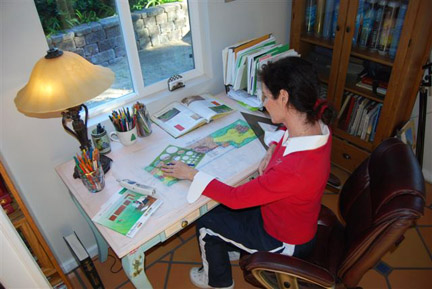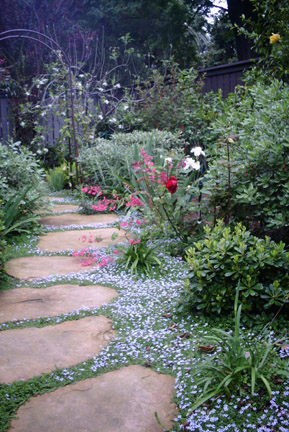by Annie St. Claire
 What would you do with an abundance of fruits and vegetables grown right in your very own home or garden. With your food savings, you might be able to spend your hard earned money on a family vacation this year.
What would you do with an abundance of fruits and vegetables grown right in your very own home or garden. With your food savings, you might be able to spend your hard earned money on a family vacation this year.
More and more these days, it is becoming more environmentally and economically correct to do urban farming and have your own edible garden. With the current economic climate, people are encouraged stretch their budgets tighter than ever before. Growing your own garden, may help cut down on escalating food prices and actually make it possible to befriend your neighbors with your harvested edibles.
If you own your own home, setting aside a space to create your own garden may be a delightful option to purchasing fruit and vegetables in a store. If you rent your home, there are still many options available to you to provide your family with the fruits of your labor. Either way, you can rest assured that you are doing the very best you can to provide quality, nutritious fruits and vegetables for your family.
Starting your Garden:
Consider what you would like to grow in your garden and how much space you can allocate for your plants to grow. For a family of 4 with enough left over to feed your neighbors, consider starting with 25 square feet per person if you can. Check with your local nursery or agricultural office to see what type of food sources grow well in your area. Purchasing seeds online is easier than ever before and local home improvement stores are becoming great sources for potted fruits and vegetables these days.
Raised Beds: Planting a raised garden bed is a very simple way to ease the stress and strain of digging into cold or hard soil to plant your edibles. Simply place wood or concrete blocks around the outside edges of your garden and backfill with a good organic soil. If it is possible to install a drip system or irrigation system, this is the most ideal way to keep your plants in good shape over the growing season with a minimal attrition rate. Then set your plants in rows with a name tag at the end so you remember what you planted and maintain as necessary until your plants are ready to harvest. Be sure to fertilize your plants to keep your plants producing abundantly.
Pots: This is a great way to have your edibles in a small space or near your kitchen. I always get clay pots because they handle heat better and are easy to care for. Put a great organic soil in each pot and install drip irrigation system if possible. Find a mixture of edible plants that you like and plug them in the soil. Three to four different types will grow well together in a pot.
Hydroponics: There are new hydroponic companies sprouting up all over the United States that specialize in growing plants in small space containers indoors. Kits can be purchased that contain all the necessary ingredients to grow these amazing plants. If you truly have a lack of space outdoors, then this is your item. The internet is filled with useful tips to growing huge amounts of fruits, grains and veggies in abundance in these container gardens.
Growing Edibles Throughout the Garden:
Growing edibles throughout your garden is a great way to make sure you have an abundance of fruits and veggies not only for your own family, but to share with neighbors as well. Many fruit or nut trees as well as berry plants can be planted in amongst your regular ornamental plantings and will survive very well. If you have small children, make sure you train them on what they can and can’t eat in the garden. Encourage your neighbors to do the same thing with different varieties than what you are growing and you can share your harvest together. If you are lucky, someone on the block knows how to can the fruits of your labor and you’re set through the winter months.
Consider hiring your local landscape designer if you are unsure of how to grow your edible garden. These trained professionals are practiced in the art of urban farming and can work with you to design and install the garden of your choice. They can even work with your neighbors to help create a co-op of edibles to be shared in the neighborhood. Whatever your goals, Landscape Design professionals can assist you in your urban gardening needs.
Annie St. Claire is a licensed General Contractor and landscape designer working in the Greater Los Angeles area. For a consultation, please call 818 353-0757. Visit her website at www.throughthewoodsdesign.com

 The first step is to look at the big picture of what you want your home to ultimately look like. Sit down, write up a list of everything you want to do to fix up your home and garden, or maybe you just want to start from scratch and build from the bottom up. Whatever your goals for your home are, write them out on a piece of paper and make Xerox copies for any design professional that will need them. If this is a project to be done over time, assign a date of completion to each item you have. This puts your thoughts in the physical universe and helps you to stay on target with your goals.
The first step is to look at the big picture of what you want your home to ultimately look like. Sit down, write up a list of everything you want to do to fix up your home and garden, or maybe you just want to start from scratch and build from the bottom up. Whatever your goals for your home are, write them out on a piece of paper and make Xerox copies for any design professional that will need them. If this is a project to be done over time, assign a date of completion to each item you have. This puts your thoughts in the physical universe and helps you to stay on target with your goals. You might have a gardening nightmare on your hands if:
You might have a gardening nightmare on your hands if: